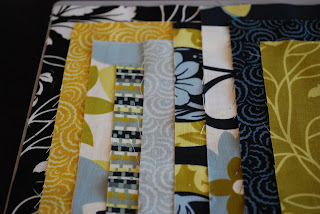

Working with one stack of the 1.25" width logs, start assembling the log cabin block.
Take your centre (1.75"x1.75") and log #2 and sew with 1/4" seam allowance (SA) along the length of the centre block. Trim off excess log and square up.

Add next log in a clockwise position on second side of central square. The third log on the third side, etc. Continue to square-up block and pressing SA away from central block.

When logs are not long enough, sew 2 identical logs together on short ends (this is where I use up the cut off portions from stack #1). Continue sewing logs until the block is about 9"x9".


Pin the three layers together to hold in place, and trim the battings to just beyond the edges of the block. I chose to use the "Stitch-in-the-ditch" quilting method, but feel free to use whatever you prefer! After you've completed all the quilting stitches, make sure to stitch all around the block in a very narrow SA to secure the edges. Trim batting edges to align with the fabric.
 Find a coordinating ribbon scrap (about 5" long); fold in half and place edges on one of the corners diagonally. Pin in place and stitch in corner on diagonal close to the corner, backstitching for extra reinforcement.
Find a coordinating ribbon scrap (about 5" long); fold in half and place edges on one of the corners diagonally. Pin in place and stitch in corner on diagonal close to the corner, backstitching for extra reinforcement. Find a coordinating cotton fabric (for the backing) and cut to the same size as the quilted hot pad. Place good side of backing fabric on good side of quilted block and stitch a narrow seam (about ¼") leaving approximately 2" opening on a side to allow for turning right side out.
Find a coordinating cotton fabric (for the backing) and cut to the same size as the quilted hot pad. Place good side of backing fabric on good side of quilted block and stitch a narrow seam (about ¼") leaving approximately 2" opening on a side to allow for turning right side out. Trim corners and turn right side out. Finish by edge stitching around the hot pad; turning opening edges inward to enclose raw edges.
Trim corners and turn right side out. Finish by edge stitching around the hot pad; turning opening edges inward to enclose raw edges.

VOILA! Admire your finished project, and make a matching one!
I'd love to hear what you think as this is my first tutorial! And by all means, if there's a better and/or faster way to do the block piecing, I'd love to hear that too! Thanks for stopping by! Happy Stitching!





looks great! nice fabric, too!!
ReplyDelete